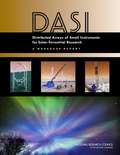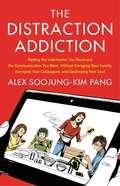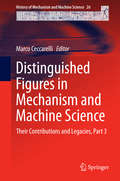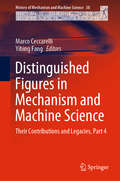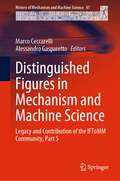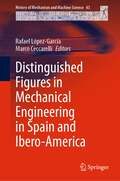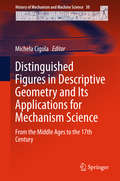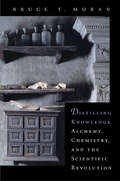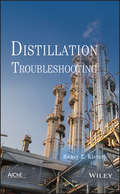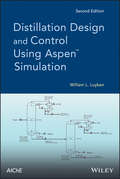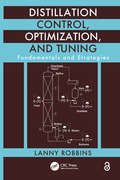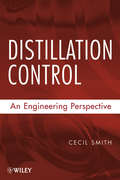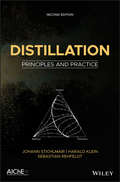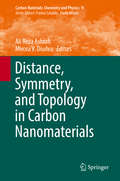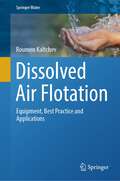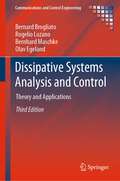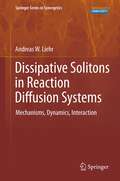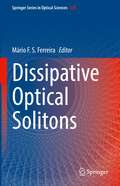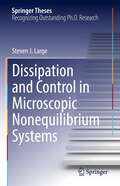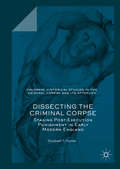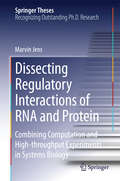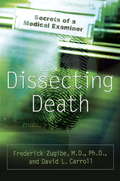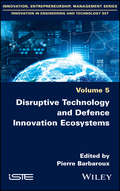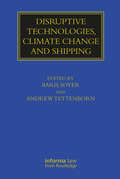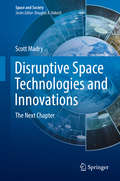- Table View
- List View
Distributed Arrays of Small Instruments for Solar-Terrestrial Research: Report of a Workshop
by National Research Council of the National AcademiesA recommendation of the NRC’s decadal survey in solar and space physics, published in 2002, was the Small Instrument Distributed Ground-Based Network, which would provide global-scale ionospheric and upper atmospheric measurements crucial to understanding the atmosphere-ionosphere-magnetosphere system. To explore the scientific rationale for this distributed array of small instruments (known as DASI), the infrastructure needed to support and make use of such arrays, and proposals for a deployment implementation plan, the NRC held a workshop of interested parties at the request of the National Science Foundation. This report presents a summary of that workshop focusing on the science and instruments, and on infrastructure issues. It describes the themes emerging from the workshop: the need to address the magnetosphere-ionosphere-magnetosphere ensemble as a system; the need for real-time observations; and the insufficiency of current observations.
The Distraction Addiction: Getting the Information You Need and the Communication You Want, Without Enraging Your Family, Annoying Your Colleagues, and Destroying Your Soul
by Alex Soojung-Kim PangThe question of our time: can we reclaim our lives in an age that feels busier and more distracting by the day? We've all found ourselves checking email at the dinner table, holding our breath while waiting for Outlook to load, or sitting hunched in front of a screen for an hour longer than we intended. Mobile devices and the web have invaded our lives, and this is a big idea book that addresses one of the biggest questions of our age: can we stay connected without diminishing our intelligence, attention spans, and ability to really live? Can we have it all? Alex Soojung-Kim Pang, a renowned Stanford technology guru, says yes. THE DISTRACTION ADDICTION is packed with fascinating studies, compelling research, and crucial takeaways. Whether it's breathing while Facebook refreshes, or finding creative ways to take a few hours away from the digital crush, this book is about the ways to tune in without tuning out.
Distinguished Figures in Mechanism and Machine Science
by Marco CeccarelliThis is the second volume of a series of edited books whose aim is to collect contributed papers in a frame that can be a sort of dictionary of personalities in MMS (Mechanism and Machine Science). The papers will illustrate personalities by recognizing persons and their activity, by looking mainly at technical developments in the historical evolution of the fields that today are grouped in MMS. Thus, emphasis will be addressed also to biographical notes to describe efforts and experiences of people who have contributed to the technical achievements whose survey is the core of each contributed paper. It is a unique perspective for technical experts to go further in-depth into the historical background of their topics of expertise. This second volume of the dictionary project has been possible thanks to the invited authors who have enthusiastically shared the initiative and prepared the papers with joint characteristics of survey and historical notes. These papers cover the wide field of the History of Mechanical Engineering with specific focus on MMS. Readers can benefit from the papers in this book and future ones with further satisfaction and motivation for her or his own work (historical or not).
Distinguished Figures in Mechanism and Machine Science: Their Contributions and Legacies, Part 4 (History of Mechanism and Machine Science #38)
by Marco Ceccarelli Yibing FangThis book discusses technological developments by distinguished figures in the history of MMS (mechanism and machine science). It includes biographies of well-known scientists, describing their efforts, experiences and achievements and offering a modern interpretation of their legacy. This volume includes scientists from a wide range of time periods, academic disciplines, and geographical backgrounds, such as Giovanni Bianchi, Homer, Taqi Al-Din, Jacques de Vaucanson, Ma Jun, Xu Baosheng, Alexander Alexandrovich Golovin, Francesco di Giorgio and Cesare Rossi. Covering a wide range of figures within the field of history of mechanical engineering, with a particular focus on MMS, this fourth volume is of interest to, and will inspire the work (historical or not) of many.
Distinguished Figures in Mechanism and Machine Science: Legacy and Contribution of the IFToMM Community, Part 5 (History of Mechanism and Machine Science #41)
by Marco Ceccarelli Alessandro GasparettoThis book discusses the technological developments achieved by distinguished figures in the history of mechanism and machine science (MMS). This is the fifth volume of a series of books which gathered contributions on the leading scientists in the field. This book focuses specifically on the IFToMM community and its activities over the last 50 years, showcases who-is-who in MMS, and emphasizes—together with the previous books of the series—the significance of MMS through time. Each chapter recognizes persons whose scientific work resulted in relevant technical developments in the historical evolution of MMS within IFToMM. Biographical notes describing the efforts and achievements of these persons are included as well, but a technical survey is the core of each chapter, offering a modern interpretation of their legacy.
Distinguished Figures in Mechanical Engineering in Spain and Ibero-America (History of Mechanism and Machine Science #43)
by Rafael López-García Marco CeccarelliThis volume collects contributions on leading figures in mechanism and machine science (MMS) from Spain and Ibero-America over the last two centuries. The contributions examine scientists whose work resulted in relevant technical-scientific achievements, with an impact on technology and science in the historical evolution of MMS fields, and with an influence on the development of society at large. Biographical notes describing the efforts and achievements of these persons are included as well, but a technical survey is the core of each chapter, offering a modern interpretation of their legacy.
Distinguished Figures in Descriptive Geometry and Its Applications for Mechanism Science
by Michela CigolaThis book consists of chapters that focus specifically on single figures that worked on Descriptive Geometry and also in Mechanisms Sciences and contain biographical notes, a survey of their work and their achievements, together with a modern interpretation of their legacy. Since Vitruvius in ancient times, and with Brunelleschi in the Renaissance, the two disciplines began to share a common direction which, over the centuries, took shape through less well-known figures until the more recent times in which Gaspard Monge worked. Over the years, a gap has been created between Descriptive Geometry and Mechanism Science, which now appear to belong to different worlds. In reality, however, there is a very close relationship between the two disciplines, with a link based on extremely solid foundations. Without the theoretical foundations of Geometry it would not be possible to draw and design mechanical parts such as gears, while in Kinematics it would be less easy to design and predict the reciprocal movements of parts in a complex mechanical assembly.
Distilling Knowledge: Alchemy, Chemistry, and the Scientific Revolution (New Histories of Science, Technology, and Medicine)
by Bruce T. MoranAlchemy can't be science--common sense tells us as much. But perhaps common sense is not the best measure of what science is, or was. In this book, Bruce Moran looks past contemporary assumptions and prejudices to determine what alchemists were actually doing in the context of early modern science. Examining the ways alchemy and chemistry were studied and practiced between 1400 and 1700, he shows how these approaches influenced their respective practitioners' ideas about nature and shaped their inquiries into the workings of the natural world. His work sets up a dialogue between what historians have usually presented as separate spheres; here we see how alchemists and early chemists exchanged ideas and methods and in fact shared a territory between their two disciplines. Distilling Knowledge suggests that scientific revolution may wear a different appearance in different cultural contexts. The metaphor of the Scientific Revolution, Moran argues, can be expanded to make sense of alchemy and other so-called pseudo-sciences--by including a new framework in which "process can count as an object, in which making leads to learning, and in which the messiness of conflict leads to discernment." Seen on its own terms, alchemy can stand within the bounds of demonstrative science.
Distillation Troubleshooting
by Henry Z. KisterTHE FIRST BOOK OF ITS KIND ON DISTILLATION TECHNOLOGY The last half-century of research on distillation has tremendously improved our understanding and design of industrial distillation equipment and systems. High-speed computers have taken over the design, control, and operation of towers. Invention and innovation in tower internals have greatly enhanced tower capacity and efficiency. With all these advances, one would expect the failure rate in distillation towers to be on the decline. In fact, the opposite is the case: the tower failure rate is on the rise and accelerating. Distillation Troubleshooting collects invaluable hands-on experiences acquired in dealing with distillation and absorption malfunctions, making them readily accessible for those engaged in solving today's problems and avoiding tomorrow's. The first book of its kind on the distillation industry, the practical lessons it offers are a must for those seeking the elusive path to trouble-free distillation. Distillation Troubleshooting covers over 1,200 case histories of problems, diagnoses, solutions, and key lessons. Coverage includes: * Successful and unsuccessful struggles with plugging, fouling, and coking * Histories and prevention of tray, packing, and internals damage * Lessons taught by incidents and accidents during shutdowns, commissioning, and abnormal operation * Troubleshooting distillation simulations to match the real world * Making packing liquid distributors work * Plant bottlenecks from intermediate draws, chimney trays, and feed points * Histories of and key lessons from explosions and fires in distillation towers * Prevention of flaws that impair reboiler and condenser performance * Destabilization of tower control systems and how to correct it * Discoveries from shutdown inspections * Suppression of foam and accumulation incidents A unique resource for improving the foremost industrial separation process, Distillation Troubleshooting transforms decades of hands-on experiences into a handy reference for professionals and students involved in the operation, design, study, improvement, and management of large-scale distillation.
Distillation Design and Control Using AspenTM Simulation
by William L. LuybenThe new edition of this book greatly updates and expands the previous edition. It boasts new chapters on the divided wall column and carbon dioxide capture from stack gas, revises the design and control of distillation systems, and explains the use of dynamic simulation to study safety issues in the event of operating failures. Using Aspen Plus to develop rigorous simulations of single distillation columns and sequences of columns, the book considers the economics of capital investment and energy costs to create an optimal system for separation methods in the chemical and petroleum industries.
Distillation Control, Optimization, and Tuning: Fundamentals and Strategies
by Lanny RobbinsWith a focus on the fundamentals and strategies of distillation columns, this book covers the process variables for continuous distillation columns, as well as four basic control strategies and the typical cases in which they are used. The author defines the inlet and outlet streams and process variables for a distillation column and then explains the overall concept of the separation and purification that is performed. Performance and product quality are described in terms of specification requirements, and tools and techniques for the optimization of quality performance are provided. Figures and graphs are included within the reference to illustrate concepts.
Distillation Control
by Cecil L. SmithLearn to Design the Best Control Configuration for Any Distillation Column Today, distillation is by far the most common separation technique used in the chemical and petroleum industries. All distillation columns need to be carefully controlled in order to meet specified production and quality levels. Distillation Control enables readers to do this by approaching the subject from a process to develop, analyze, and troubleshoot all aspects of column controls. Readers are efficiency and effectiveness and minimizing coats. Distillation Control begins with a chapter dedicated to underlying principles, including separation processes, reflux and boilup ratios, and composition dynamics. Next, the author covers such critical topics as: Composition control Pressure control and condensers Reboilers and feed preheaters Application of feedforward Unit optimization Complex towers As readers progress through the text, they'll discover that the best control configuration for a distillation column is largely determined using steady-state process characteristics. The stage-by-stage separation models that the author sets forth for column design, therefore, provide information that is essential in developing the optimal control configuration. In addition to its clear explanations, Distillation Control is filled with clear diagrams and illustrations that clarify complex concepts and guide readers through multi-step procedures. Engineers as well as other professionals working in process facilities that use distillation to separate materials will fin that this book enables them to implement the latest tested and proven distillation control methods to meet their particular processing needs.
Distillation: Principles and Practice
by Johann G. Stichlmair Harald Klein Sebastian RehfeldtDistillation Principles and Practice Second Edition covers all the main aspects of distillation including the thermodynamics of vapor/liquid equilibrium, the principles of distillation, the synthesis of distillation processes, the design of the equipment, and the control of process operation.Most textbooks deal in detail with the principles and laws of distilling binary mixtures. When it comes to multi-component mixtures, they refer to computer software nowadays available. One of the special features of the second edition is a clear and easy understandable presentation of the principles and laws of ternary distillation. The right understanding of ternary distillation is the link to a better understanding of multi-component distillation. Ternary distillation is the basis for a conceptual process design, for separating azeotropic mixtures by using an entrainer, and for reactive distillation, which is a rapidly developing field of distillation.Another special feature of the book is the design of distillation equipment, i.e. tray columns and packed columns. In practice, empirical know-how is preferably used in many companies, often in form of empirical equations, which are not even dimensionally correct. The objective of the proposed book is the derivation of the relevant equations for column design based on first principles. The field of column design is permanently developing with respect to the type of equipment used and the know-how of two-phase flow and interfacial mass transfer.
Distance, Symmetry, and Topology in Carbon Nanomaterials
by Ali Reza Ashrafi Mircea V. DiudeaThis contributed volume is inspired by the seminal discoveryand identification of C60. Starting with a comprehensive discussion featuringgraphene based nanostructures, subsequent chapters include topologicaldescriptions of matrices, polynomials and indices, and an extended analysis ofthe symmetry and topology of nanostructures. Carbon allotropes such as diamondand its connection to higher-dimensional spaces is explored along withimportant mathematical and topological considerations. Further topics coveredinclude spontaneous symmetry breaking in graphene, polyhedral carbonstructures, nanotube junction energetics, and cyclic polyines as relatives ofnanotubes and fullerenes. This book is aimed at researchers active in the studyof carbon materials science and technology.
Dissolved Air Flotation: Equipment, Best Practice and Applications (Springer Water)
by Roumen KaltchevThis book provides an overview of the dissolved air flotation clarification technology. It brings together the three strands of knowledge and experience accumulated in this field - the analysis of the main phenomena involved and the interactions between them, the equipment for its implementation and its main applications in water treatment. The author draws attention to the design and operation of the different equipment used in practice, their advantages, and disadvantages in the different fields of application of this technology.The book is intended for:•Engineers and technicians working on the design of equipment and its integration into the overall water treatment plant as well as in the operation of flotation plants.•Consultants and engineering offices, hoping that it will help them to make the most appropriate choices regarding the applications of this process, as well as in the equipment selections.•Wastewater treatment plants operators, in the hope that it will help them to optimise the operation of their plants and improve their understanding and analysis of some problems they may encounter.•Purchasers and contractors, who have to make sometime difficult choices for reducing costs and, at the same time, ensure and guarantee the long-term performance and reliability of the plant.The book is oriented towards the practical side of implementing the technology. It contains a lot of information about the equipment (much more than in all other available publications on the same subject) as well as practical comments and recommendations that are very rarely found in this kind of book, written mostly by researchers. It will appeal to specialists who are comfortable with water chemistry, but it may also be of interest to water professionals who are more interested in the equipment, design and operation of water treatment plants.
Dissipative Systems Analysis and Control: Theory and Applications (Communications and Control Engineering)
by Rogelio Lozano Bernard Brogliato Bernhard Maschke Olav EgelandThis second edition of Dissipative Systems Analysis and Control has been substantially reorganized to accommodate new material and enhance its pedagogical features. It examines linear and nonlinear systems with examples of both in each chapter. Also included are some infinite-dimensional and nonsmooth examples. Throughout, emphasis is placed on the use of the dissipative properties of a system for the design of stable feedback control laws.
Dissipative Solitons in Reaction Diffusion Systems
by Andreas W. LiehrWhy writing a book about a specialized task of the large topic of complex systems? And who will read it? The answer is simple: The fascination for a didactically valuable point of view, the elegance of a closed concept and the lack of a comprehensive disquisition. The fascinating part is that field equations can have localized solutions exhibiting the typical characteristics of particles. Regarding the field equations this book focuses on, the field phenomenon of localized solutions can be described in the context of a particle formalism, which leads to a set of ordinary differential equations covering the time evolution of the position and the velocity of each particle. Moreover, starting from these particle dynamics and making the transition to many body systems, one considers typical phenomena of many body systems as shock waves and phase transitions, which themselves can be described as field phenomena. Such transitions between different level of modelling are well known from conservative systems, where localized solutions of quantum field theory lead to the mechanisms of elementary particle interaction and from this to field equations describing the properties of matter. However, in dissipative systems such transitions have not been considered yet, which is adjusted by the presented book. The elegance of a closed concept starts with the observation of self-organized current filaments in a semiconductor gas discharge system. These filaments move on random paths and exhibit certain particle features like scattering or the formation of bound states. Neither the reasons for the propagation of the filaments nor the laws of the interaction between the filaments can be registered by direct observations. Therefore a model is established, which is phenomenological in the first instance due to the complexity of the experimental system. This model allows to understand the existence of localized structures, their mechanisms of movement, and their interaction, at least, on a qualitative level. But this model is also the starting point for developing a data analysis method that enables the detection of movement and interaction mechanisms of the investigated localized solutions. The topic is rounded of by applying the data analysis to real experimental data and comparing the experimental observations to the predictions of the model. A comprehensive publication covering the interesting topic of localized solutions in reaction diffusion systems in its width and its relation to the well known phenomena of spirals and patterns does not yet exist, and this is the third reason for writing this book. Although the book focuses on a specific experimental system the model equations are as simple as possible so that the discussed methods should be adaptable to a large class of systems showing particle-like structures. Therefore, this book should attract not only the experienced scientist, who is interested in self-organization phenomena, but also the student, who would like to understand the investigation of a complex system on the basis of a continuous description.
Dissipative Optical Solitons (Springer Series in Optical Sciences #238)
by Mário F. S. FerreiraThis book introduces the basic concept of a dissipative soliton, before going to explore recent theoretical and experimental results for various classes of dissipative optical solitons, high-energy dissipative solitons and their applications, and mode-locked fiber lasers.A soliton is a concept which describes various physical phenomena ranging from solitary waves forming on water to ultrashort optical pulses propagating in an optical fiber. While solitons are usually attributed to integrability, in recent years the notion of a soliton has been extended to various systems which are not necessarily integrable. Until now, the main emphasis has been given to well-known conservative soliton systems, but new avenues of inquiry were opened when physicists realized that solitary waves did indeed exist in a wide range of non-integrable and non-conservative systems leading to the concept of so-called dissipative optical solitons. Dissipative optical solitons have many unique properties which differ from those of their conservative counterparts. For example, except for very few cases, they form zero-parameter families and their properties are completely determined by the external parameters of the optical system. They can exist indefinitely in time, as long as these parameters stay constant. These features of dissipative solitons are highly desirable for several applications, such as in-line regeneration of optical data streams and generation of stable trains of laser pulses by mode-locked cavities.
Dissipation and Control in Microscopic Nonequilibrium Systems (Springer Theses)
by Steven J. LargeThis thesis establishes a multifaceted extension of the deterministic control framework that has been a workhorse of nonequilibrium statistical mechanics, to stochastic, discrete, and autonomous control mechanisms. This facilitates the application of ideas from stochastic thermodynamics to the understanding of molecular machines in nanotechnology and in living things. It also gives a scale on which to evaluate the nonequilibrium energetic efficiency of molecular machines, guidelines for designing effective synthetic machines, and a perspective on the engineering principles that govern efficient microscopic energy transduction far from equilibrium. The thesis also documents the author’s design, analysis, and interpretation of the first experimental demonstration of the utility of this generally applicable method for designing energetically-efficient control in biomolecules. Protocols designed using this framework systematically reduced dissipation, when compared to naive protocols, in DNA hairpins across a wide range of experimental unfolding speeds and between sequences with wildly different physical characteristics.
Dissecting the Criminal Corpse
by Elizabeth T. HurrenThose convicted of homicide were hanged on the public gallows before being dissected under the Murder Act in Georgian England. Yet, from 1752, whether criminals actually died on the hanging tree or in the dissection room remained a medical mystery in early modern society. Dissecting the Criminal Corpse takes issue with the historical cliché of corpses dangling from the hangman's rope in crime studies. Some convicted murderers did survive execution in early modern England. Establishing medical death in the heart-lungs-brain was a physical enigma. Criminals had large bull-necks, strong willpowers, and hearty survival instincts. Extreme hypothermia often disguised coma in a prisoner hanged in the winter cold. The youngest and fittest were capable of reviving on the dissection table. Many died under the lancet. Capital legislation disguised a complex medical choreography that surgeons staged. They broke the Hippocratic Oath by executing the Dangerous Dead across England from 1752 until 1832. This book is open access under a CC-BY license.
Dissecting Regulatory Interactions of RNA and Protein
by Marvin JensThe work described in this book is an excellent example of interdisciplinary research in systems biology. It shows how concepts and approaches from the field of physics can be efficiently used to answer biological questions and reports on a novel methodology involving creative computer-based analyses of high-throughput biological data. Many of the findings described in the book, which are the result of collaborations between the author (a theoretical scientist) and experimental biologists and between different laboratories, have been published in high-quality peer-reviewed journals such as Molecular Cell and Nature. However, while those publications address different aspects of post-transcriptional gene regulation, this book provides readers with a complete, coherent and logical view of the research project as a whole. The introduction presents post-transcriptional gene regulation from a distinct angle, highlighting aspects of information theory and evolution and laying the groundwork for the questions addressed in the subsequent chapters, which concern the regulation of the transcriptome as the primary functional carrier of active genetic information.
Dissecting Death: Secrets of a Medical Examiner
by David L. Carroll Frederick ZugibeFrom TV's CSI to bestsellers by Patricia Cornwell and Kathy Reichs, interest in forensics is at an all-time high. Now one of our most respected forensic pathologists gives a behind-the-scenes look at eleven of his most notorious cases, cracked by scientific analysis and Sherlock Holmesian deduction. As chief medical examiner of Rockland County, New York, for almost thirty-five years, Dr. Frederick Zugibe literally wrote the book on the subject--his widely used textbook is considered the definitive text. Over the years he has pioneered countless innovations, including the invention of a formula to soften mummified fingers--enabling fingerprinting, and thus identification, of a long-deceased victim. He has appeared as an expert hundreds of times in the media and in the courtroom--and not once has a jury failed to accept his testimony over opposing expert witnesses. And now, in Dissecting Death, he has opened the door to the world of forensic pathology in all its gruesome and fascinating mystery. Dr. Zugibe takes us through the process all good pathologists follow, using eleven of his most challenging cases. With him, we visit the often grisly--though sometimes shockingly banal--crime scene. We inspect the body, palpate the wounds, search for clues in the hair and skin. We employ ultraviolet light, strange measuring devices, optical instruments. We see how a forensic pathologist determines the hour of death, the type of weapon used, the killer's escape route. And then we enter the lab, the world of high-tech criminal detection: DNA testing, fingerprinting, gunshot patterns, dental patterns, X-rays. But not every case ends in a conviction, and in a closing chapter Dr. Zugibe examines some recent high-profile cases in which blunders led to killers going free, either because the wrong party was brought to trial or because the evidence presented didn't do the trick--including Jon-Benet Ramsey's murder and, of course, the O. J. Simpson trial.
Disruptive Technology and Defence Innovation Ecosystems
by Pierre BarbarouxRecent advances in the disciplines of computer science (e.g., quantum theory, artificial intelligence), biotechnology and nanotechnology have deeply modified the structures of knowledge from which military capabilities are likely to develop. This book discusses the implications of disruptive technologies for the defence innovation ecosystem. Two complementary dimensions of the defence innovation ecosystem are highlighted: the industrial and intra-organizational. On the industrial scale, there is a shift in the ecology of knowledge underpinning the defence industrial and technological base (DITB). At the intra-organizational level, it is the actors’ practices that change and, through them, their skills and the processes by which they are acquired and transferred. In this context, the sources and legitimacy of innovation are being transformed, in turn requiring sometimes radical adaptations on the part of the various actors, including companies, military services, research communities and governmental agencies, which make up the defence innovation ecosystem.
Disruptive Technologies, Climate Change and Shipping (Maritime and Transport Law Library)
by Simon Baughen Andrew Tettenborn Bariş SoyerThis book analyses the impact of two vital and contemporary developments on shipping law and practice: disruptive technologies and climate change. It considers the impact of these new technologies, honing in on likely emerging issues and unresolved questions, especially about existing and potential private law liabilities and concentrates, from the point of view of English, EU and international law, on the legal implications of climate change and associated environmental risks in the shipping sector. Written by a contributor team drawn from the most experienced and knowledgeable academics and practitioners in shipping law, this treatment of these growing areas of practice will be of great use to lawyers and administrators across the world.
Disruptive Space Technologies and Innovations: The Next Chapter (Space and Society)
by Scott MadryIn the past century alone, we have witnessed groundbreaking technological innovations quickly displace established industries, thereby opening up entirely new markets or fields of research. Such "disruptive technologies" are hard to predict in advance, and yet, they have the potential to significantly alter the course of history. Written by one of the world’s leading space applications experts, this book addresses the concept of disruptive technologies in the space arena, including microsatellites, the development of satellite constellations, and reusable launch vehicles.The book presents several case studies in the field, and discusses how and why modern space technologies are so unique. It covers current examples of disruptive space businesses, the pros and cons of such disruption, key emerging trends, and possible developments on the horizon.
